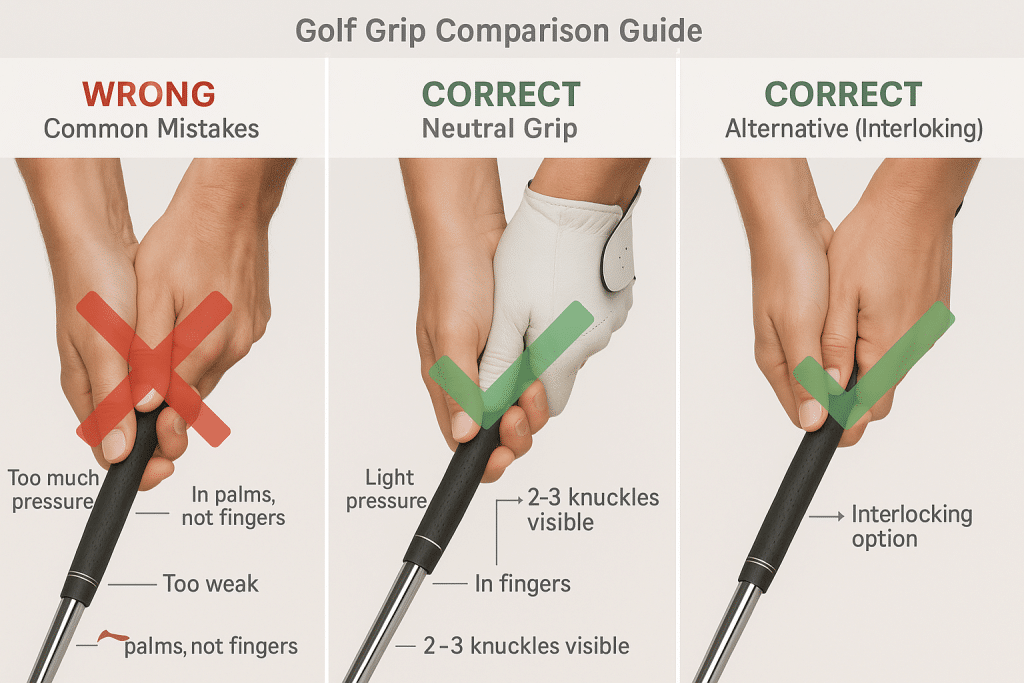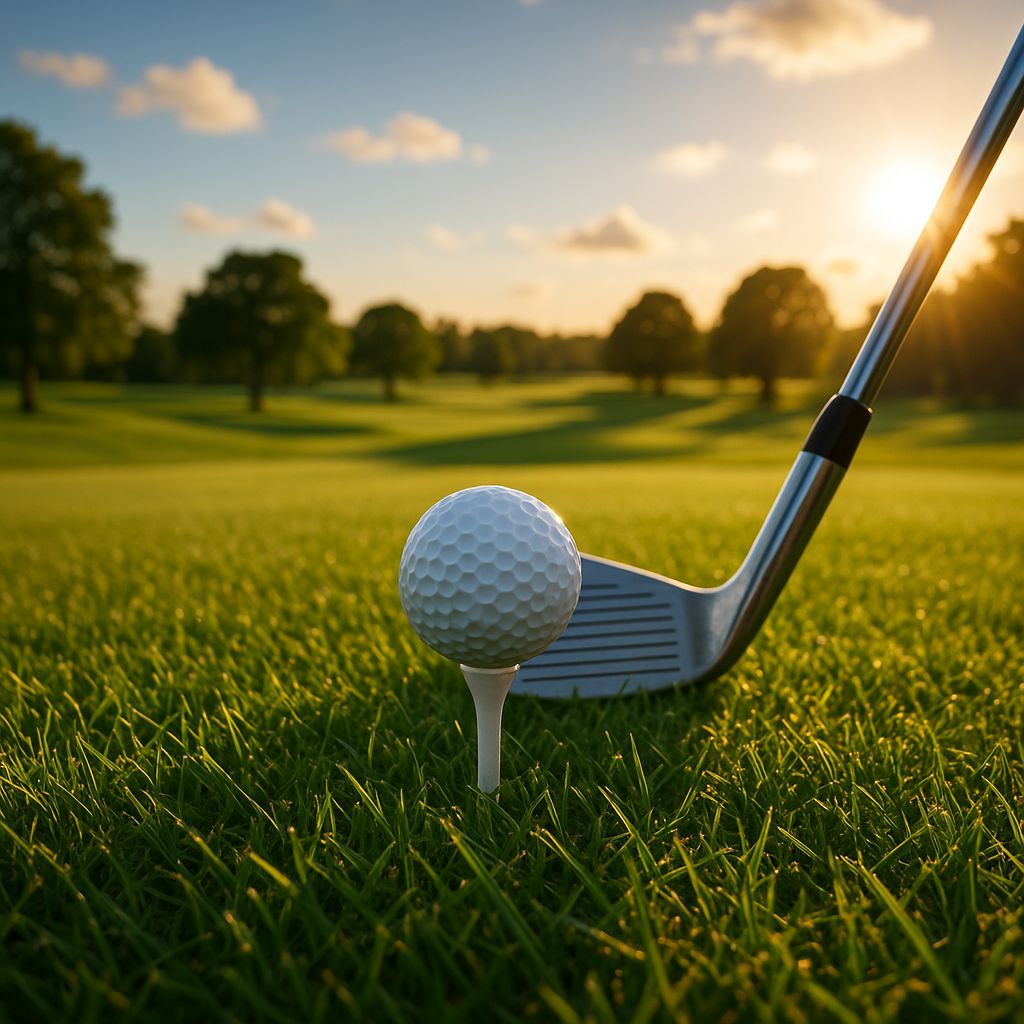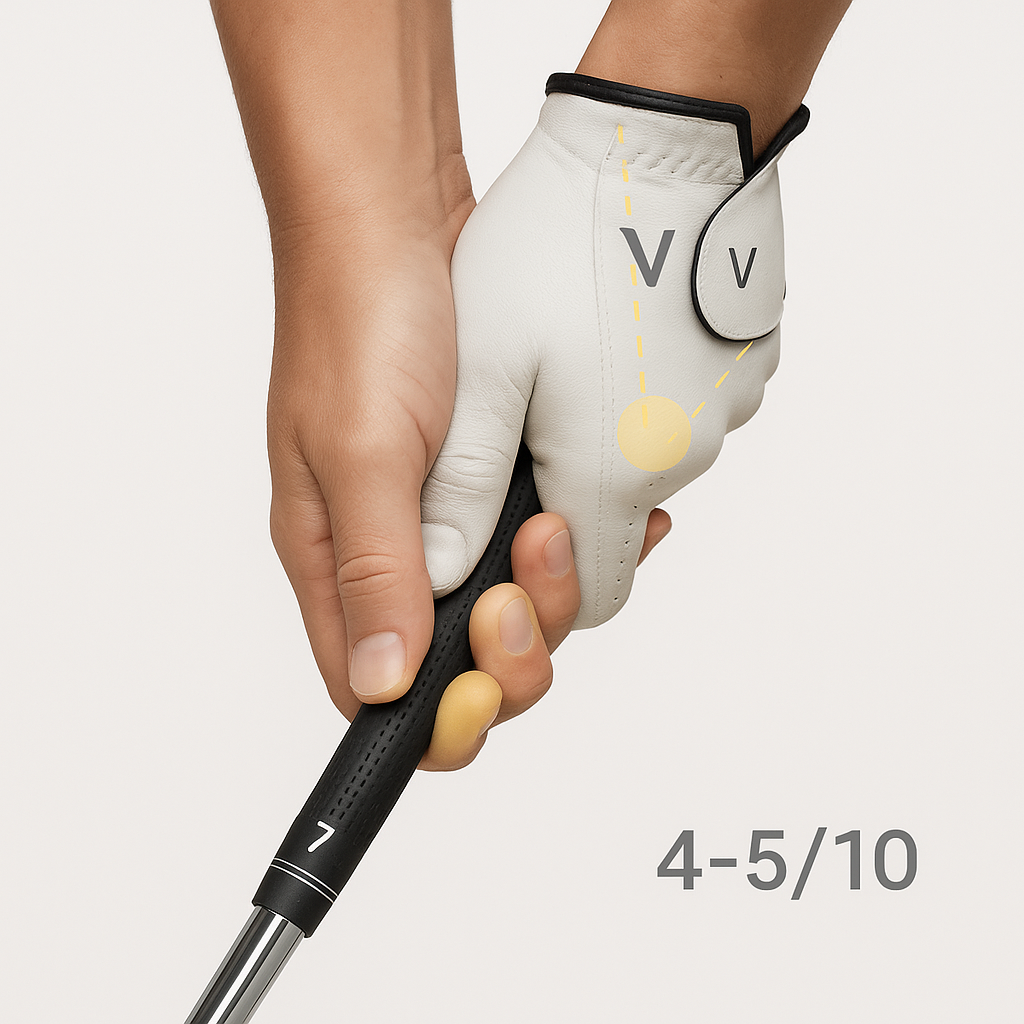Key Takeaways
- Your grip is the only physical connection to your golf club, making it the foundation of a consistent and powerful swing
- Excessive grip pressure is one of the most common mistakes, with ideal pressure being around 4-5 on a scale of 10
- The position of your hands (too strong or too weak) directly affects ball flight and can be the root cause of persistent slices or hooks
- Most amateur golfers fail to maintain a consistent grip across different clubs, leading to inconsistent shot patterns
- Simple grip checks like the V-formation test can quickly identify if your grip is causing your swing problems
Mastering proper golf grip fundamentals is essential for every golfer, from beginners learning how to hold a golf club to experienced players fine-tuning their technique. The right golf grip pressure and hand positioning can instantly transform your swing, while common golf grip mistakes continue to plague millions of golfers worldwide.
Your golf grip is the foundation of your entire swing. Get it wrong, and you're fighting an uphill battle before you even start your takeaway. I've seen countless golfers blame their swing mechanics when their grip was the true culprit all along.
What is the Proper Golf Grip Pressure?
The ideal golf grip pressure is 4-5 on a scale of 1-10, where 10 is the tightest possible grip. This allows for control without restricting wrist movement or creating tension in your arms. Sam Snead famously described the perfect grip pressure as “holding a bird—firm enough that it can't fly away, but gentle enough that you don't hurt it.”
How Should You Hold a Golf Club?
- Place the club in your fingers, not your palms – The handle should run diagonally across your fingers
- Position your hands so you can see 2-3 knuckles on your lead hand when looking down at address
- Maintain light pressure (4-5 out of 10) throughout your entire swing
- Ensure your hands work as a unified connection with proper overlap or interlock
The way you hold the club influences everything from your clubface position at impact to your ability to generate power. Yet many golfers spend hours working on their swing plane while neglecting this fundamental connection to the club. The good news? Fixing your grip is often simpler than rebuilding your entire swing.
Article Overview
This comprehensive guide will walk you through the most common golf grip mistakes that sabotage your performance, simple tests to identify if your grip is causing your issues, and practical fixes you can implement immediately.
Whether you're battling a persistent slice, struggling with distance, or just looking to improve consistency, understanding these golf grip fundamentals will transform your game.
Most importantly, we'll focus on solutions that don't require complete overhauls of your technique. Sometimes, the smallest adjustments yield the most dramatic improvements in golf.
Why Your Golf Grip Is Sabotaging Your Swing
Picture this: you've spent countless hours practicing your swing, watching instructional videos, and maybe even investing in golf lessons. Yet that slice persists, or your shots lack the power and consistency you know you're capable of. The frustrating truth? Your grip might be undermining all your hard work.
Your hands are the only point of contact with your golf club. This connection is so critical that grip flaws can override even the most technically sound swing mechanics. A poor grip makes it nearly impossible to deliver the clubface consistently at impact, regardless of how perfect the rest of your swing might be.
7 Most Common Golf Grip Mistakes That Ruin Your Shots
After analyzing thousands of golf swings over the years, I've identified seven grip mistakes that consistently derail golfers' performance. Recognizing these golf grip mistakes is the first step toward correcting them and unlocking your true potential on the course.

1. Excessive Grip Pressure: The Death Grip Problem
The most prevalent grip mistake I see is what I call the “death grip” syndrome. Golfers, especially when nervous or trying to hit the ball farther, squeeze the club with excessive pressure. This tension travels up your arms, restricts your wrist hinge, and severely limits both your power and control.
Think of grip pressure on a scale of 1-10, with 10 being the tightest possible grip. Most amateurs grip at 7-9 when the ideal golf grip pressure is around 4-5.
This excessive tension doesn't just reduce your distance; it makes consistent contact nearly impossible. When your hands and forearms are tense, your ability to feel the clubhead throughout the swing diminishes drastically. This leads to fat shots, thin shots, and an overall lack of consistency.
Quick Fix for Grip Pressure:
- Practice with grip pressure at a 3-4 level, which will feel uncomfortably light at first
- Focus on maintaining consistent pressure throughout your swing, not just at address
- Take practice swings with your eyes closed, focusing solely on the feel of the clubhead
- Try the “tee between teeth” drill – if your jaw tightens during your swing, you're likely gripping too firmly
2. Improper Hand Placement on the Club
The position of your hands on the club determines your ability to square the clubface at impact. Many golfers place their hands too far toward the palm instead of more in the fingers, which reduces wrist mobility and makes it difficult to release the club properly through impact.
For proper golf grip technique, your hands should work as a unit, with the handle running diagonally across your fingers from the base of your pinky finger to just above the first joint of your index finger.
3. Golf Grip Too Strong or Too Weak
A “strong” grip (where your hands are rotated too far to the right for right-handed golfers) or a “weak” grip (hands rotated too far left) dramatically affects your ball flight. This isn't about strength—it's about the rotation of your hands on the club.
A grip that's too strong often causes hooks or low, drawing shots, while a grip that's too weak typically produces slices or high, fading shots.
The V-Formation Test: The telltale sign of grip strength issues appears in what's called your “V's”—the creases formed between your thumbs and index fingers. For a neutral grip, these V's should point somewhere between your trailing shoulder and your chin.
4. Inconsistent Grip Across Different Clubs
Many golfers unknowingly change their grip when switching between their driver, irons, and wedges. This inconsistency makes it nearly impossible to develop a repeatable swing. While subtle adjustments between clubs can be beneficial for advanced players, most amateurs should maintain consistent golf grip fundamentals throughout their bag.
5. Wrong Grip Type for Your Hand Size
Golf Grip Types Explained:
- Baseball Grip (Ten-Finger): All ten fingers on the club, ideal for beginners and smaller hands
- Interlocking Grip: Pinky finger interlocks with index finger, popular among tour players
- Overlapping Grip (Vardon): Most common among professionals, pinky rests between fingers
6. Ignoring Weather Conditions
Weather significantly impacts proper golf grip technique. Hot, humid conditions require adjustments to prevent slipping, while cold weather can lead to unconsciously tighter gripping.
7. Misaligned Grip That Doesn't Match Your Swing
Your grip should complement your natural swing tendencies, not fight against them. Many golfers adopt a textbook grip without considering how it interacts with their unique swing pattern.
How to Check If Your Grip Is Causing Your Golf Problems
Before making any changes to your golf grip technique, you need to determine whether it's actually the source of your issues. These three simple tests can quickly reveal if your grip is the true culprit behind your inconsistent shots.
The V-Formation Test for Golf Grip
Take your normal grip and look down at your hands. The “V” formed between your thumb and index finger on each hand should point somewhere between your trailing shoulder and chin for a neutral grip. If these V's are pointing outside your trailing shoulder, your grip is too strong. If they point toward your lead shoulder, your grip is too weak.
Shot Pattern Analysis
Your ball flight provides valuable clues about golf grip mistakes:
- Persistent slice: Often indicates a grip that's too weak
- Consistent hook: Suggests a grip that's too strong
- Low ball flight: Grip might be too far underneath the club
- High, ballooning shots: Could mean your grip is too much on top
Look for patterns rather than individual shots. When 7 out of 10 shots curve the same way, your grip is likely contributing to the problem.
Mirror Check Method for Proper Golf Grip
Stand in front of a mirror with your normal grip. Compare what you see to reference photos of proper golf grip technique. Pay special attention to:
- Visibility of knuckles on both hands
- Position of the club in your fingers versus your palms
- Overall alignment of your hands
Fix Your Golf Grip in 3 Simple Steps
Correcting your golf grip fundamentals doesn't require complex changes or months of practice. By following these three straightforward steps, you can transform your grip—and your golf game—in a single practice session.
Important Notes:
- Start with a clean slate—regrip the club completely rather than trying to adjust your existing grip
- Make changes during practice sessions, not in the middle of a round
- Give yourself time to adapt to the new feeling—it will feel uncomfortable at first
- A properly adjusted grip will feel strange for approximately 500 to 1,000 repetitions
Step 1: Find Your Ideal Golf Grip Pressure (4-5 on a Scale of 10)
Start by holding the club with minimal pressure—around a 2 on our 1-10 scale. Take a few practice swings, gradually increasing pressure until you find the sweet spot where you maintain control without tension.
You should feel the club primarily in your fingers, not squeezed deep into your palms. A helpful image is to imagine holding a tube of toothpaste without squeezing any paste out—firm enough for control but light enough to prevent tension.
Step 2: Position Your Hands Correctly
Place the club in your fingers rather than your palms, with the handle running diagonally across your fingers. For right-handed golfers, position your left hand so you can see 2-3 knuckles when looking down at address.
The lifeline of your right hand should fit snugly over your left thumb, creating a unified connection. This positioning creates the proper leverage needed for both power and control through impact.
Step 3: Match Your Grip to Your Natural Swing Tendencies
Adjust your grip slightly based on your natural swing pattern and miss tendencies:
- If you struggle with slicing: Consider strengthening your grip by rotating both hands slightly to the right
- If hooking is your issue: Weaken your grip by rotating your hands slightly left
Make small, incremental adjustments rather than dramatic changes. Hit 5-10 balls after each minor adjustment until you find the position that produces your desired ball flight.
Best Golf Grip Types for Different Player Levels
Beginners: The Baseball Golf Grip
If you're new to golf or have smaller hands, the baseball grip (ten-finger grip) provides excellent control and feel. This is often the best golf grip for beginners because:
- It's the most intuitive grip style
- Allows focus on fundamental swing mechanics
- Reduces strain on fingers and provides maximum leverage
- Works well for junior golfers and players with limited hand strength
Intermediate Players: Interlocking Golf Grip Benefits
The interlocking grip—preferred by Tiger Woods, Jack Nicklaus, and Rory McIlroy—involves interlocking the pinky finger of your trailing hand with the index finger of your lead hand.
Benefits of Interlocking Grip:
- Helps hands work as a single unit through impact
- Provides more consistency in your release
- Prevents the dominant hand from taking over
- Particularly benefits players with average-sized hands
Advanced Players: Overlapping (Vardon) Golf Grip
The overlapping grip is the most popular choice among tour professionals. With this grip, the pinky finger of your trailing hand rests in the groove between the index and middle fingers of your lead hand.
Advanced Player Benefits:
- Facilitates a freer wrist hinge and release
- Can translate to more power and shot-shaping ability
- Works best for players with larger hands or strong wrists
- Promotes a more fluid release through impact
Quick Golf Grip Fixes for Common Shot Problems
Stop Slicing: Strengthen Your Golf Grip
If you consistently battle a slice, try strengthening your lead hand position:
- Rotate your left hand slightly more to the right on the club
- You should see 3-4 knuckles when looking down at address
- Place your trailing hand more underneath the club rather than on top
- This stronger position encourages better rotation through impact
Fix Your Hook: Weaken Your Golf Grip
For golfers struggling with hooks:
- Rotate both hands slightly left until you see only 1-2 knuckles on your lead hand
- This adjustment helps prevent the clubface from closing too quickly
- Start with minimal changes and gradually adjust
- Be careful not to overdo this adjustment
Gain Distance: Focus on Hand Alignment
To maximize distance with proper golf grip technique:
- Position the club more in your fingers rather than deep in your palms
- Increase wrist hinge and leverage potential
- Ensure your trailing hand isn't positioned too much on top of the club
- Focus on pressure in the middle pad of your trailing index finger
Improve Accuracy: Create Consistent Pressure Points
Accuracy stems from consistently returning the clubface to square at impact:
- Identify specific pressure points where you feel the most connection
- Typically the last three fingers of your lead hand and middle finger of your trailing hand
- These pressure points should remain consistent throughout your swing
- Experiment with the “trigger finger” technique used by many tour professionals
Golf Grip Training Drills You Can Do Anywhere
The Towel Drill for Proper Golf Grip Pressure
Roll up a small hand towel to approximately the same diameter as your golf grip. Practice holding this towel with your golf grip, focusing on maintaining consistent pressure throughout an imaginary swing.
Benefits:
- The softness provides immediate feedback about excessive pressure
- Can be done anywhere without a club
- Trains consistent pressure regardless of swing dynamics
- Perform 50-100 repetitions daily for best results
Alignment Stick Exercise for Hand Position
Place an alignment stick between your fingers and palms in your normal grip position. The stick should run diagonally across your fingers, not straight across your palms.
Why This Works:
- Reinforces proper hand placement
- Develops awareness of grip shifts during swing
- Highlights difference between finger-based and palm-based grips
- Perform for 5-10 minutes before each practice session
Golf Grip Equipment Guide
Best Golf Grips for Different Conditions
Humid/Hot Weather:
- Cord grips for extra traction
- Tacky compound grips
- Consider grip-enhancing products
Cold Weather:
- Softer compound grips for better feel
- Slightly larger diameter for winter gloves
- Hand warmers to maintain sensitivity
Wet Conditions:
- All-weather grips with drainage channels
- Rain gloves that become tackier when wet
- Extra towels and grip maintenance
Golf Glove Selection for Optimal Grip
A properly fitted golf glove provides several advantages:
- Increases friction between hand and club
- Reduces grip pressure needed for control
- Provides consistency throughout the round
- Essential for hot, humid conditions
Professional Golfer Grip Analysis
Tour Player Grip Variations
Strong Grippers:
- Paul Azinger: Extremely strong grip that helped eliminate his slice
- David Duval: Strong grip that produced his signature draw
Weak Grippers:
- Ben Hogan: Famously weak grip that helped cure his hook
- Corey Pavin: Weak grip that produced consistent fade shots
Neutral Grippers:
- Adam Scott: Textbook neutral grip
- Jason Day: Slightly strong but very consistent
What We Can Learn from the Pros
Professional golfers prove that there's no single “correct” grip for everyone. The key is finding what works consistently for your swing tendencies and physical attributes.
Golf Grip Mistakes by Handicap Level
High Handicap (20+ Handicap) Common Mistakes
- Death grip syndrome (excessive pressure)
- Club too deep in palms
- Inconsistent grip between clubs
- Wrong grip type for hand size
Mid Handicap (10-20 Handicap) Common Mistakes
- Subtle grip changes under pressure
- Incorrect grip strength for swing path
- Seasonal grip inconsistencies
- Equipment-related grip issues
Low Handicap (Under 10 Handicap) Common Mistakes
- Over-tinkering with fundamentals
- Pressure-sensitive grip changes
- Weather adaptation failures
- Equipment transition difficulties
FAQ Section
What golf grip does Tiger Woods use?
Tiger Woods uses an interlocking grip with a neutral to slightly strong position. His grip has evolved throughout his career, with recent adjustments to accommodate back issues and swing changes.
Should I use an overlapping or interlocking grip?
The choice depends on your hand size and personal preference:
- Interlocking: Better for smaller hands and players wanting maximum hand unity
- Overlapping: Preferred by players with larger hands and those wanting more wrist freedom
How do I know if my golf grip is too strong?
Signs of a too-strong grip include:
- Consistent hooks or draws
- Low ball flight
- Difficulty hitting fades
- Seeing more than 3 knuckles on your lead hand at address
Should I use the same grip for my driver as my irons?
For most amateur golfers, maintaining consistent grip fundamentals across all clubs creates the most reliable results. However, subtle adjustments can benefit specific situations—slightly higher hand position for driver, lower for wedges.
How often should I check and adjust my golf grip?
- Quick grip check before each shot during practice
- Comprehensive assessment at the beginning of each season
- Monthly checks with a teaching professional
- Immediate review after any consistent ball flight issues
Can changing my grip fix my slice immediately?
Yes, grip changes often produce immediate improvements in ball flight. Strengthening your lead hand position can quickly reduce slicing by helping close the clubface through impact. However, dramatic changes require an adjustment period for best results.
Do I need to wear a golf glove for a proper grip?
While not absolutely necessary, a properly fitted golf glove provides several advantages:
- Increased friction for better control
- Reduced grip pressure requirements
- Consistency throughout the round
- Essential protection in humid conditions
How do weather conditions affect my golf grip?
- Hot/Humid: Requires slightly firmer pressure, extra gloves, towels
- Cold: Focus on avoiding death grip despite reduced feel
- Rain: Increase pressure 15-20%, use rain gloves, frequent grip drying
What's the difference between a strong and weak golf grip?
- Strong Grip: Hands rotated more to the right (for right-handed golfers), tends to promote draws/hooks
- Weak Grip: Hands rotated more to the left, tends to promote fades/slices
- Neutral Grip: Hands positioned so V's point between chin and trailing shoulder
How long does it take to adjust to a new golf grip?
A properly adjusted grip typically feels natural after 500-1,000 repetitions. With concentrated practice, this can be achieved in just a few dedicated sessions. Initial discomfort is normal and doesn't indicate the change is wrong.
Transform Your Game With Proper Golf Grip Fundamentals
The grip is golf's most fundamental building block—the foundation upon which your entire swing is built. Even small improvements in how you hold the club can yield dramatic results in your ball striking, consistency, and shot dispersion. Unlike complex swing changes that might take months to implement, golf grip adjustments can produce immediate benefits.
“The moment of truth in golf is the split second it takes for your clubhead to travel through the hitting zone. Everything that happens before and after is just preparation and consequence. A proper grip gives you the best chance of delivering the clubface correctly during that crucial moment.”
Give yourself permission to feel uncomfortable during the adjustment period. Your old grip—even if technically flawed—feels natural simply because you've used it for so long. The discomfort of a new grip position typically fades after 500-1,000 repetitions, leaving you with improved mechanics and more consistent results.
Remember that golf grip refinement isn't a one-time fix but an ongoing process. As your swing evolves and your physical capabilities change, occasional grip adjustments will help you maintain optimal performance. The most successful golfers regularly check their fundamentals, with grip assessment being a top priority.
Action Steps:
- Assess your current grip using the tests in this guide
- Identify your primary grip mistake from the seven common errors
- Implement the appropriate fix using our 3-step process
- Practice consistently with your new grip for 500+ repetitions
- Monitor your ball flight patterns for improvement
- Schedule regular grip check-ups with a golf professional
Master these golf grip fundamentals, and you'll have built the foundation for a lifetime of improved golf performance.


